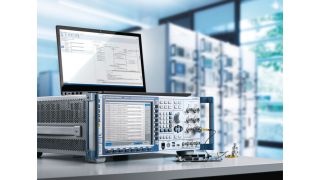Testing eSIM compliance and remote SIM provisioning
Ensure that your M2M device equipped with an embedded SIM can deliver permanent and ubiquitous connectivity around the globe

Ensure that your M2M device equipped with an embedded SIM can deliver permanent and ubiquitous connectivity around the globe


Embedded subscriber identity modules (eSIM) have long replaced the traditional SIM cards used in the mobile industry. eSIMs are integrated into mobile devices, for instance in car telematics units, in machine-to-machine (M2M) devices such as industrial sensors or in consumer devices such as mobile phones, wearables and tablets. Vendors can use eSIMs to optimize their hardware design. This results in much smaller devices thanks to the smaller form factor and replacing the SIM card slot with a small chip.
A great advantage of eSIM over the traditional SIM card is the ability to remotely change the SIM profile – in particular the operator subscription – without physically changing the eSIM itself. This is extremely important for the M2M market since device vendors can store multiple operator profiles simultaneously on one device and remotely switch between them – although only one can be used at a time. This is necessary because changing the SIM cards in remote locations has been problematic for many industrial applications.
Soldering an eSIM to an M2M device or a car telematics unit poses new challenges. Once permanently installed or soldered into the device, changing or updating the card profile requires new methods. The Groupe Spécial Mobile Association (GSMA) introduced an initiative to define specifications for eSIM cards.
The aim is to provide global standards for remote provisioning and management of M2M connections that allow over-the-air provisioning of an initial operator subscription and subsequent switching of subscriptions from one operator to another. Core specifications (SGP.02) and test specifications (SGP.11) ensure that eSIM cards deliver robust, secure and ubiquitous connectivity after field adaptation.
From 2020 onward, tests for the emergency call system ERA-GLONASS will become standard for the automotive industry. Introduced in the Euroasian Economic Union (EAEU), the test requirements for eSIMs are described in the Russian GOST specifications (chapter 9, GOST 33470). Test solutions for the development phase are required to verify compliance with the standards and to ensure that downloading, updating and deleting a profile works properly.
Test tool provider COMPRION, in cooperation with Rohde & Schwarz, has developed a new testing architecture for testing eSIM compliance and remote SIM provisioning. This eSIM testing solution combines the eUICC profile manager software tool from COMPRION with either the R&S®R&S®CMW500 wideband radio communication tester or the R&S®CMW290 functional communication tester.
The solution focuses on quality assurance, especially on interface compliance, as well as system and platform behavior testing in line with GSMA specifications. The tests verify that remote provisioning of an eSIM, e.g. downloading, updating and deleting a profile, works the way it should.
In addition to eUICC compliance testing, the eUICC profile manager and the RSP M2M platform from COMPRION provide advanced testing capabilities for use case based remote provisioning scenarios. The communications interface to the device under test (DUT) is the R&S®CMW500 or the R&S®CMW290, which supports all common cellular radio standards such as LTE, WCDMA and GSM as well as IoT standards such as NB-IoT in a single unit.
The COMPRION software running on an external PC is connected via Ethernet to the R&S®CMW wideband radio communication tester. The R&S®CMW simulates the relevant network configured within the software and transmits the messages from the COMPRION software to the DUT. Together with the R&S®CMW-Z10 RF shield box and R&S®CMW-Z11 antenna coupler, the solution provides the complete mobile network simulation necessary to test the compliance of remote SIM provisioning implementations.
Mobile network operators (MNO), test houses and device manufacturers who need to ensure that over-the-air (OTA) updates work well now have a test solution that covers their needs. With the possibility to extend the setup with the R&S®CMX500 radio communication tester for future applications, including 5G New Radio (5G NR), the test solution is a state-of-the-art investment.


Test setup for eSIM testing: Soldered eUICCs via network simulator R&S®CMW500 wideband radio communication tester or R&S®CMW290 functional communication tester